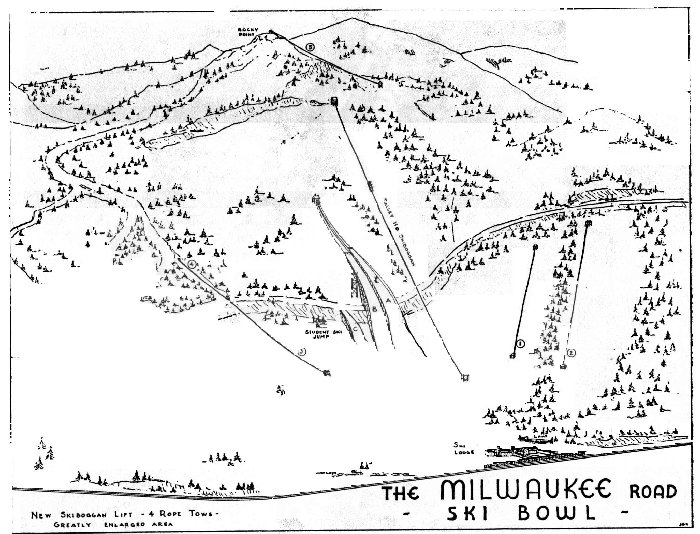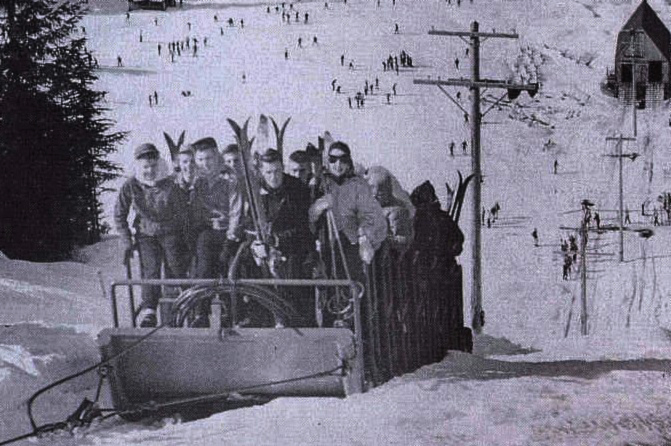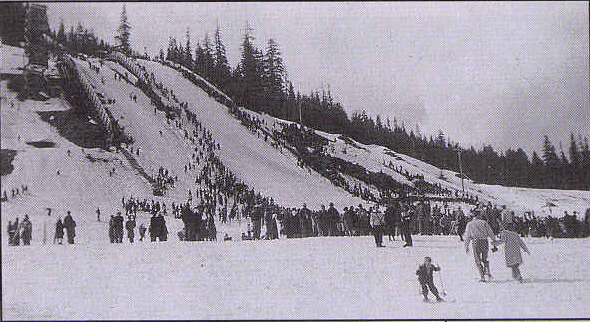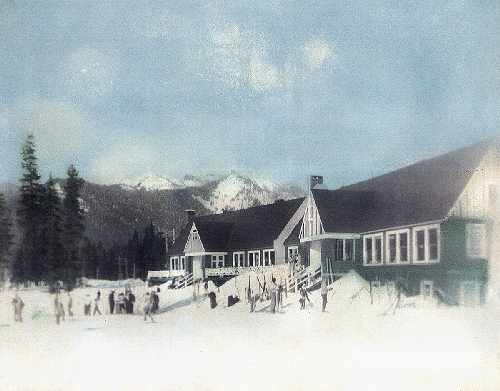
In this week’s edition of The Abandoned, we will take a look at one of Washington’s old gems: the Snoqualmie Ski Bowl. Last week we went over Cuchara Mountain Resort in south-central Colorado. You can check that article out here:
Snoqualmie Ski Bowl was the first ski resort on Snoqualmie Pass, a major winter destination for those who live in the Seattle-Tacoma-Bellevue metro area. Built by the Milwaukee Road Railroad in 1937, the resort operated until 1951. The resort did close down from 1942-1945 due to WWII but was reopened in 1946 for 5 more years. After the resort re-opened, it was renamed the Milwaukee Ski Bowl as to not be confused with the now opened Snoqualmie Summit Ski Area.
The resort boasted a 1,500-foot vertical drop with a peak elevation of 4,000 feet. The 1946 season trail map can be seen above with the layout of the resort. Most of the lift access was via rope tows, but Snoqualmie Ski Bowl did offer one extremely unique lift, the Tally-Ho Skiboggan. This ground riding toboggan lift feels like almost the pre-cursor to trams and gondola lifts. Always cool to see how people got up resorts in the early years!

Another unique feature of the resort was that the ski area was mainly accessed via trains. In the first season of operation, the 1937-38 season, 11,000 visitors came to the resort on trains that ran on Saturday’s and Sunday’s. While there was a road on the pass, it was usually too difficult to open all winter. It took until 1931 when the road had its first winter of full operation, and even then it was not paved. The idea behind the resort was that it allowed winter travelers to go skiing without the rigors of having to drive the dangerous mountain roads at the time.
The ski bowl also offered world-class ski jumping at the time. It operated the largest ski jump in North America at the time. This allowed the ski area to host the U.S. Ski Jumping Olympic Trials in 1947 as seen in the photograph below. For many, this jump was not only the biggest but also the best built and maintained in all of North America. Due to the great jumping facilities, the resort hosted a multitude of National Ski Jumping Championships.

As mentioned before, WWII closed the resort for a while, but it reopened in 1946. Unfortunately, the lodge burned down in 1949 and the resort was forced to operate out of rail cars until it eventually closed its doors in 1951. The ski community truly has deep roots in Washington and Snoqualmie Ski Bowl is proof.

The Milwaukee Ski Bowl is not the same as Summit East, they used different areas of the mtn. If you want a look at lost ski areas you need to join the “Lost Ski Areas of Washington” on facebook.
You can also find info on all 48 lost ski area sites at http://www.lostskiareas.wikidot.com
my mom and dad used to go up to this area from Tacoma with friends of theirs that was also from Tacoma
Interesting article. I re-learned to ski at Snoqualmie Pass about 1975 when I moved back to Seattle. I road a ski bus up for lessons on Wed. nights. It was a lot of fun & much easier with all the new equipment, shorter skis & padded boots. My 1st attempt was in a college class on Mt. Baker, with wooden skis as long as I could reach, torture type leather boots, & clamp on bindings. I actually enjoyed it in-spite of the blisters I endured & many falls learning to do a kick turn with those big long skis.
I can relate! At the University of Colorado, I took the ski bus for the first two years to get up to the mountains. Always had a love/hate relationship with it but it was a great system. Thanks for sharing 🙂
Have you heard of Satus Pass Ski area on Hiway 97. The lodge burned down in the 1980s but I learned to ski on that hill in the 60s and 70s. There was a rope and a T bar and didn’t get much snow….now there would seldom be enough snow to open.
I have not heard of Satus Pass but thanks for sharing it! I’ll look into it 🙂
I believe this area now called “Snoqualmie East” and is still in operation (weekends only w/night skiing). Cool pic of the Skiboggan those dudes look psyched rocking their 210cms.
Hey Jack! Thanks for the comment! Glad to see that the resort, while very different from what it was back then (skiboggan’s and all), is still getting used!
Out of curiosity, using Google Earth, the profiles of the territory at Hyak seem very similar to Hyak. However, the peak elevation of 4000ft at the top of the current ski area is around 3600ft. It is an Interesting history story.